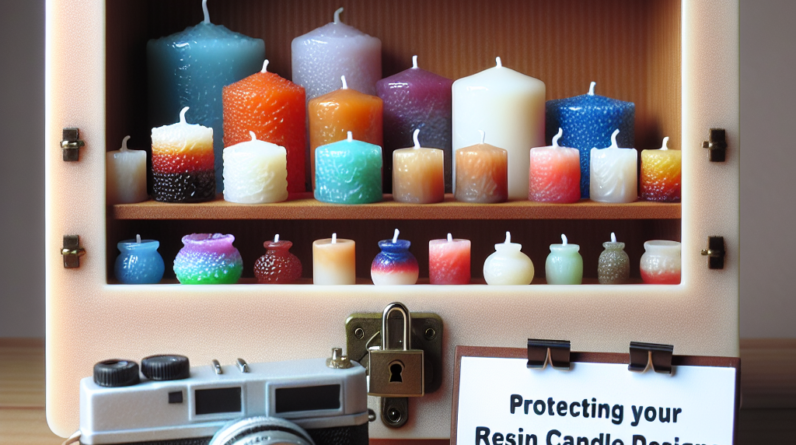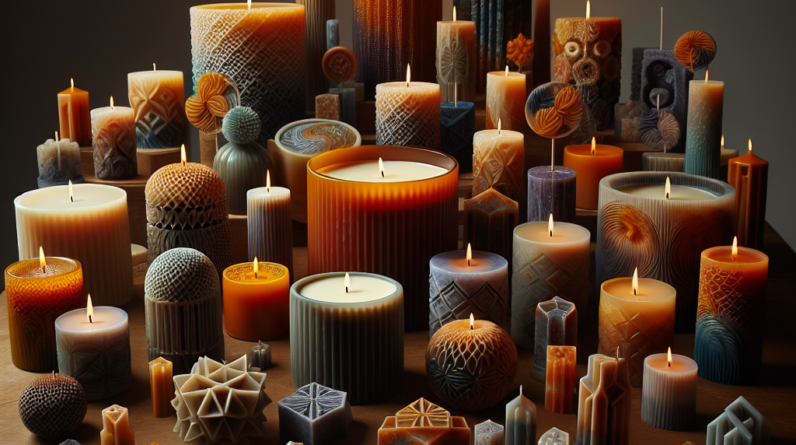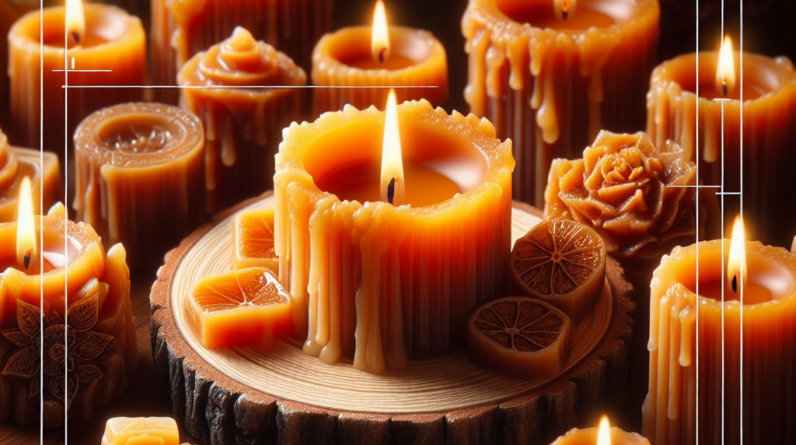
As a resin candle maker, I’ve learned a thing or two about the legal side of things. It’s not just about crafting beautiful designs; it’s equally crucial to protect them. Let’s break down how to legally safeguard your unique creations, shall we?
1. Understanding Intellectual Property Rights
What is Intellectual Property?
Intellectual Property (IP) refers to creations of the mind—like your awesome resin candle designs. This includes anything from trademarks to patents, and yes, copyrights! Understanding this is the foundation for any crafty entrepreneur.
For instance, as I delved into resin candle making, I realized that my designs could be protected under copyright law. This gives me exclusive rights to reproduce my artwork, preventing others from copying my unique ideas.
Does this mean you need to know everything about intellectual property? Nope! Just familiarize yourself with the basics, so you can take steps to protect your work effectively.
Why is Protecting Your Work Important?
Protecting your resin candle designs legally helps avoid the heartbreak of seeing your ideas sprout legs and walk away. You’ve put your heart into your creations, right? The last thing you want is someone else cashing in on your creative genius.
Accurate protection means you can confidently showcase your creations in workshops, shows, and online without worrying about infringement. Plus, it adds credibility to your brand—customers love knowing they’re buying something unique and protected!
At the end of the day, it’s about claiming ownership of your hard work. And trust me, the peace of mind that comes with securing your IP is priceless.
Types of Intellectual Property for Candle Makers
As a resin candle designer, you have a few options to explore. Copyright protects your original artistic works, like any custom designs you create. Trademarks can shield your brand name or logo—think of it as your signature in the candle world.
If your design process is totally innovative, you might even consider a patent, although this is rarer for crafts like candle making. It’s worth looking into because it can prevent others from using your unique techniques or processes.
Getting a solid grip on these IP types can really empower you as a creator. Plus, investing a little time upfront can save you a ton of legal hassle down the road.
2. Registering Your Designs
Why Registration Matters
Even though copyright protection kicks in automatically, registering your designs can give you an upper hand if you ever need to defend your work legally. It’s a bit like wearing a seatbelt—you may not need it, but it’s nice to know it’s there!
When you register your work, you establish a public record of your ownership. This can be super helpful in case someone tries to claim your designs as their own or if you need to take legal action against infringement.
In my journey, I learned that proactively registering my designs turned out to be a solid investment. It added an extra layer of protection I didn’t know I needed until I faced a potential infringement situation.
Steps to Register Your Designs
The registration process can seem a bit intimidating, but it’s pretty straightforward once you get the hang of it. Start by gathering your designs and any relevant information about their creation. This could include sketches, prototypes, and even the story behind each piece!
Next, head to your country’s copyright office website to fill out the necessary forms. You’ll need to pay a fee, which varies, so budget accordingly. It usually only takes a few weeks to get your registration completed, and then you can officially claim your work!
Don’t forget to keep records related to your design process. This documentation can serve as valuable evidence if you ever need to defend your rights down the road.
What Happens After Registration?
Once your designs are registered, congratulations! You’ll enjoy added peace of mind. Should an issue arise, you have documented evidence of ownership, which makes it easier to prove your case.
Plus, being registered can open doors for partnerships or licensing opportunities with other businesses. They’re more likely to work with you if they know your designs are legally protected.
And trust me, the added credibility can take your business up a notch. It feels good to know that you’re taking every necessary step to protect your creative investments.
3. Crafting Strong Contracts
The Importance of Contracts
As your candle-making business grows, you might collaborate with other creators or sell wholesale. This is where contracts come in. A well-crafted contract spells out the terms of your agreements and keeps everyone on the same page.
Contracts are especially valuable for protecting your designs when you share them with others. This sets clear expectations about how your designs will be used while ensuring you maintain ownership.
I’ve found that having contracts in place has saved me from misunderstandings and disputes down the line. It’s simply smart business practice!
Key Elements of a Solid Contract
When drafting a contract, there are a few vital components to include. Clearly define the roles of each party and outline how your designs can be used. Be specific about ownership rights to avoid any confusion.
Including terms regarding compensation is crucial. Are you licensing your designs, or is it a one-time sale? Clarity around payment ensures everyone knows what to expect.
Lastly, always incorporate a clause about what happens if either party doesn’t hold up their end of the bargain. This sets the groundwork for how to resolve disputes should they arise.
Consulting with a Legal Professional
If writing contracts isn’t your jam, don’t sweat it. Consulting with a legal professional can help you craft contracts that protect your interests while still being easy to understand.
Many people shy away from legal consults due to perceived costs, but in the long run, it’s a smart investment. It can prevent much larger expenses later if you need to resolve issues.
Trust me, seeking legal guidance, even for a simple contract, can save you immeasurable headaches in the future. Be sure to choose someone familiar with creative businesses like yours!
4. Building Your Brand Identity
Defining Your Brand
Your brand is more than just a name or logo; it’s your identity in the marketplace. Feeling proud of your branding is part of ensuring your designs stand out. It’s about carving your own niche in the resin candle world!
Think about what your brand represents. Is it quirky? Elegant? Eco-friendly? Defining this helps you make strategic decisions about your designs and marketing efforts.
During my journey, finding clarity in my brand identity made decisions easier. It’s like having a compass that guides you through the wild waters of marketing and customer engagement.
Trademarking Your Brand
Once you establish your brand, consider trademarking it. This protects your brand name, logo, and any other identifiers so no one else can snag them. It’s like putting a big ‘do not disturb’ sign on your creative territory!
Trademark registration helps foster trust with your customers. They’ll feel more comfortable purchasing from a brand that’s legally protected.
Again, consultation with a professional can simplify the trademarking process for you. It’s worth the time and effort to get this nailed down early on!
Consistent Branding Across Platforms
Whatever you do, maintain consistency across all platforms. Use the same logo, colors, and messaging on your website, social media, and packaging. This helps build brand recognition and makes you memorable!
I’ve learned the hard way that inconsistency can confuse potential customers. Keep it simple, and your brand will shine like the bright candle you crafted!
As you grow, ensure that every new design or product aligns with your brand identity—this consistency reinforces trust and loyalty with your customers.
5. Staying Informed and Adapting
Keeping Up with Legal Changes
The world of copyright and trademark laws is always evolving. It’s crucial to keep yourself updated on any changes that might impact your resin candle designs. Who wants to be caught off guard, right?
Consider following reputable legal blogs, joining forums, or attending workshops to expand your knowledge. Staying updated can help you adjust your strategies if needed!
I often find that a little research here and there can help me feel confident in my decisions moving forward. Knowledge is power, my friend.
Adjusting Your Approach
As your business grows, so will your understanding of the legal landscape. Don’t be afraid to adjust your practices based on new insights. Evaluate what works for you, and refine your processes as you gain more experience.
Being adaptable can set you apart from competitors who remain stuck in their ways. Embrace change; it’s a sign of growth!
Whenever I tweak my business strategy based on newfound knowledge, it feels like a breath of fresh air. Your brand will evolve, and so should your protection strategies!
Learning from Others
One of the best ways to learn is by leaning on the experience of others. Network with fellow resin candle makers or small business owners, and share your experiences. You’ll likely pick up valuable tips on protecting your own designs along the way!
Forums and social media groups can also be a goldmine for advice and resources. Engaging with a community lets you benefit from collective knowledge and support.
Remember, you’re not alone in this journey. There’s a whole network of creatives out there, and learning from them can be equally invaluable to your own growth!
FAQs
What is the best way to protect my resin candle designs?
The best way to protect your designs is through a combination of copyright registration, trademarking your brand, and utilizing strong contracts when dealing with collaborators or retailers.
Do I need to register my designs to be protected?
No, you automatically have copyright protection as soon as you create an original work. However, registering can provide additional legal advantages if you face infringement issues.
How can I trademark my brand?
You can trademark your brand name and logo by applying through your country’s trademark office. It helps to consult with a legal expert to ensure you complete the process correctly.
What should I include in a contract?
Your contract should include definitions of roles, terms of use for your designs, payment details, and clauses regarding what happens if obligations are not met.
How do I stay informed about legal changes?
To stay informed about legal changes, consider following legal blogs, attending workshops, and joining forums or groups tailored to small business owners and creatives.






